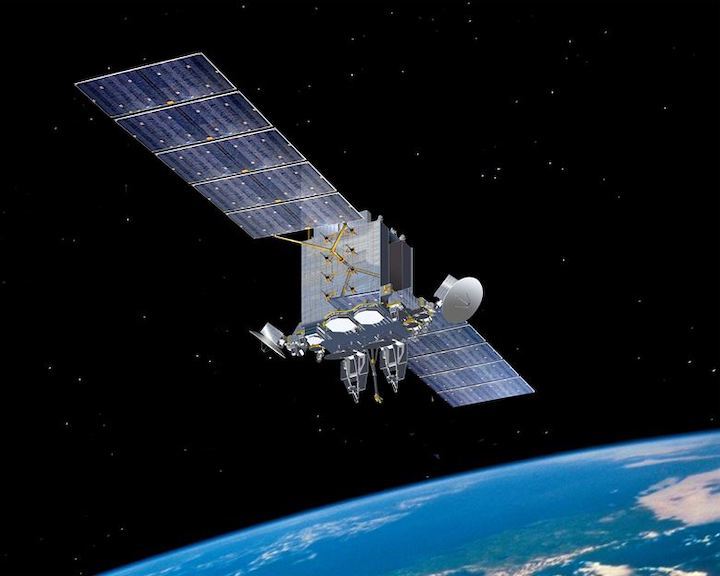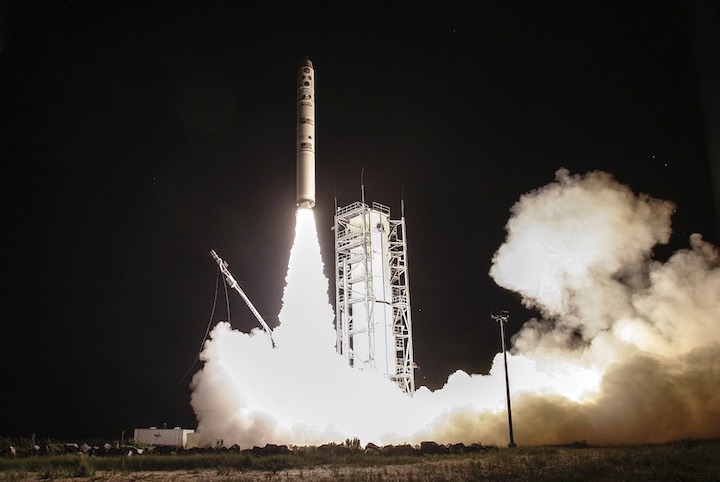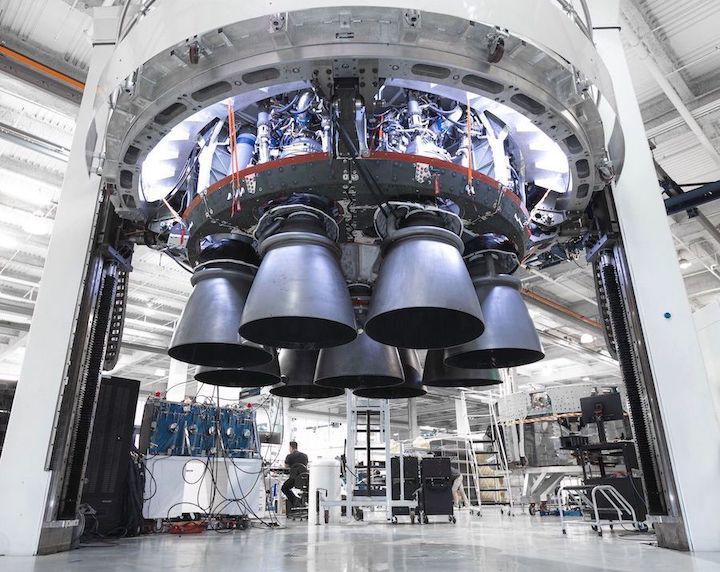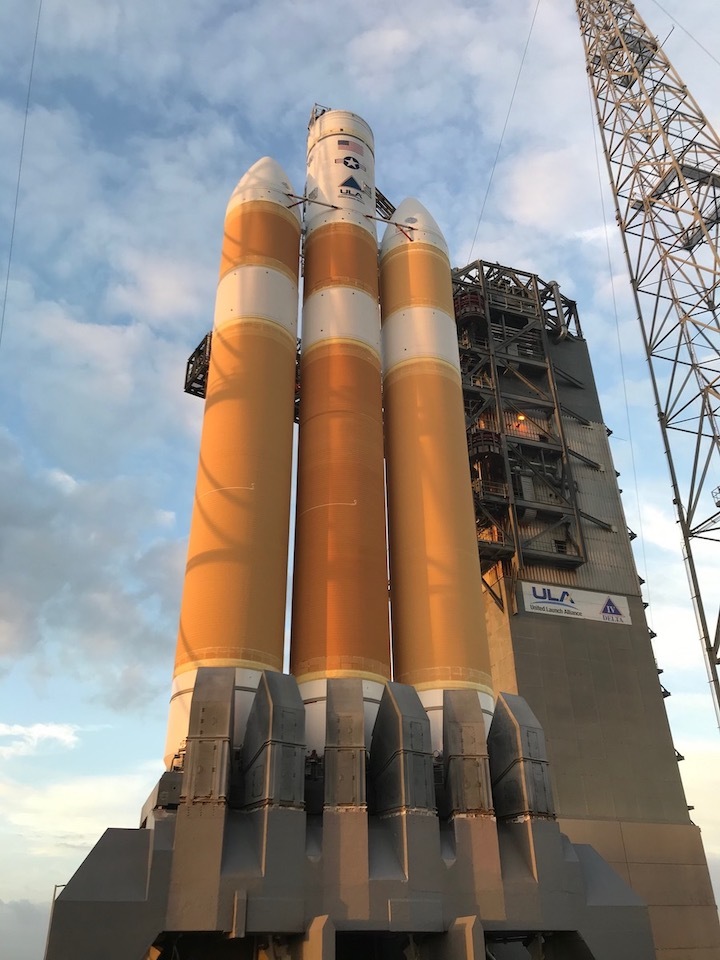The fifth Advanced Extremely High Frequency satellite was officially transferred to Space Operations Command Feb. 3, marking its final milestone
“This was very much a team effort from our industry partners and dedicated Government professionals, with their focus on mission success this major milestone was accomplished,” said Col John Dukes, senior materiel leader for the Space Production Corps’ Geosynchronous Orbit Division, in a statement. “AEHF satellites play a critical role for the warfighter and the defense of our nation. Space is fundamental to our way of life, our economy relies on space and this reliance will continue to grow.”
Built by Lockheed Martin, AEHF-5 was launched Aug. 8, 2019, on a United Launch Alliance Atlas-V rocket.
AEHF is intended to replace the MILSTAR constellation in providing protected, anti-jamming satellite communications to high-priority United States military assets and its international partners in Canada, United Kingdom, Netherlands and Australia. Just one AEHF satellites has three time more capacity than the whole MILSTAR constellation put together, and the entire AEHF constellation will provide 10 times more throughput and increase coverage.
The sixth and final AEHF satellite has been transported to Cape Canaveral, Florida, for an scheduled Mar. 19 launch aboard an Atlas V rocket.
Quelle: C4ISRNET
----
Update: 13.03.2020
.
Final AEHF satellite mated to Atlas 5 launcher at Cape Canaveral

The sixth and final satellite in the U.S. Space Force’s network of secure, jam-resistant AEHF communications satellites has been installed on top of a United Launch Alliance Atlas 5 rocket at Cape Canaveral for liftoff March 26.
Built by Lockheed Martin, the spacecraft was encapsulated inside the Atlas 5’s payload shroud — built in Switzerland by RUAG Space — and transported to the Vertical Integration Facility near Cape Canaveral’s Complex 41 launch pad Wednesday.
The AEHF 6 satellite was raised atop the Atlas 5 on its mobile launch platform inside the VIF. Tory Bruno, ULA’s CEO, confirmed Thursday on Twitter that the spacecraft “is resting comfortably atop the ‘Mighty Atlas.'”
The addition of the Advanced Extremely High Frequency payload capped assembly of the 83rd Atlas 5 launcher.
The 197-foot-tall (60-meter) rocket is scheduled for liftoff March 26 during a two-hour window opening at 2:57 p.m. EDT (1857 GMT). Earlier this week, ULA announced a two-day delay in the AEHF 6 launch to March 21 “due to an off-nominal valve reading during launch vehicle processing.”
“Additional time is needed for the team to replace and retest the valve,” ULA said in a statement.
ULA said Friday that the launch would be pushed back again to March 26 after teams needed “additional time to complete the booster valve replacement and retest.”
The Atlas 5 slated to launch the AEHF 6 satellite is flying in the “551” configuration with five strap-on solid rocket boosters and a 5.4-meter (17.7-foot) diameter payload fairing.

The AEHF 6 satellite will be the first major U.S. Space Force payload to launch after the creation of the new military branch in December. It joins five previous AEHF satellites launched on Atlas 5 rockets since 2010, continuing and expanding secure communications services for U.S. military commanders and the president provided by the military’s earlier generation of Milstar spacecraft.
The Space Force is comprised of military units that previously operated under the umbrella of the now-defunct U.S. Air Force Space Command, including space wings that manage launch ranges at Cape Canaveral Air Force Station and Vandenberg Air Force Base in California. The new Space Force military branch remains part of the Department of the Air Force, and also includes the Space and Missile Systems Center at Los Angeles Air Force Base, which oversees launch and spacecraft procurement and development programs, such as AEHF, GPS and SBIRS satellites for communications, navigation and early warning missions.
The AEHF fleet is a follow-on to the Air Force’s Milstar satellite network, and the sixth satellite will be the final craft in the constellation. The AEHF satellites are designed to operate at last 14 years.
Northrop Grumman supplies the communications payloads for the AEHF satellites, each of which provides more capacity than the entire five-satellite Milstar constellation, which launched in the 1990s and 2000s. The AEHF satellites are cross-linked with one another, allowing the network to beam signals around the world without going through a ground station.
The Atlas 5 rocket will deliver the AEHF 6 satellite into an elliptical transfer orbit, then the spacecraft will use its own engine to circularize its orbit more than 22,000 miles (nearly 36,000 kilometers) above the equator.

After reaching a preliminary orbit, the Atlas 5 will deploy a secondary payload named TDO 2 around 31 minutes after liftoff. Based on a suitcase-sized 12U CubeSat platform, TDO 2 carries multiple U.S. government payloads that will provide optical calibration capabilities, which will support space domain awareness, according to the U.S. Space Force’s Space and Missile Systems Center.
“The mission of TDO 2 is to support space domain awareness through optical calibration and satellite laser ranging,” SMC said in a statement. “This capability will assist the nation’s warfighters in performing their critical missions.”
The TDO 2 spacecraft was manufactured by Georgia Institute of Technology and sponsored by Air Force Research Laboratory, according to SMC. It is mounted to the aft end of the Atlas 5’s Centaur upper stage.
A similar secondary payload named TDO 1 accompanied the AEHF 5 satellite into orbit on a previous Atlas 5 launch in August 2019.
Quelle:SN
----
Update: 16.03.2020
.
Space and Missile Systems Center’s multi-manifest satellite vehicle ready for integration on AEHF-6 mission
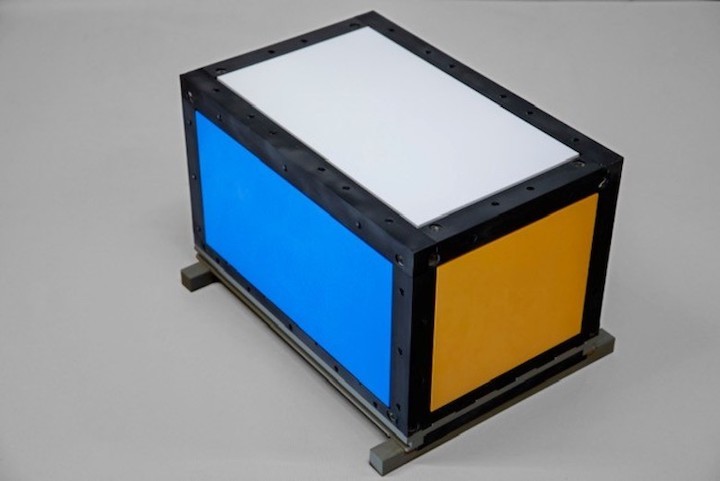
LOS ANGELES AIR FORCE BASE, Calif. --
The Space and Missile Systems Center’s Launch Enterprise Mission Manifest Office delivered a fully tested and integrated multi-manifest small satellite vehicle, known as TDO-2, to Cape Canaveral Air Force Station March 6 for integration on the Advance Extremely High Frequency (AEHF)-6 mission.
AEHF-6, slated for liftoff aboard a United Launch Alliance Atlas V 551 rocket, will mark the final satellite in the AEHF constellation, and the first launch for the newly formed U.S. Space Force.
TDO-2 is the alpha numeric name of the multi-manifest small satellite vehicle flying with the AEHF-6 mission, is carrying multiple U.S. Government payloads that will provide optical calibration capabilities, which will support space domain awareness. The mission of TDO-2 is to support space domain awareness through optical calibration and satellite laser ranging. This capability will assist the nation's warfighters in performing their critical missions. TDO-2 was manufactured by Georgia Institute of Technology and sponsored by Air Force Research Laboratory.
The payload is integrated on the aft-end of the Centaur upper stage where it will deploy the TDO-2 multi-manifest satellite vehicle approximately 31 minutes after launch. TDO-2 will deploy after the second main engine cut off (MECO 2) and prior to the anchor AEHF satellite, which is only the second time this event has occurred during a National Security Space Launch mission. Previously a hosted payload was deployed prior to AEHF-5 successfully separating.
The MMO is increasing space warfighting domain flexibility by enabling the “swap-out” capability of multi-manifest satellites late in the integration process. The AEHF-6 mission will demonstrate this “swap-out” capability by having two qualified and compatible multi-manifest satellites vehicles ready to be substituted, if needed, as late as one month prior to launch. Considering the historical integration timeline for traditional satellites is approximately 24 months, this is just another example of how SMC is driving integration flexibility and responsiveness into the National Security Space planning process and rapidly delivering capability to the warfighter.
Part of SMC’s Launch Enterprise, the MMO is blazing the way for innovation in the space warfighting domain and continuing the SMC tradition of innovation in space.
The Space and Missile Systems Center, located at Los Angeles Air Force Base in El Segundo, California, is the U.S. Space Force’s center of excellence for acquiring and developing military space systems. SMC’s portfolio includes space launch, global positioning, military space vehicle communications, defense meteorological space vehicles, range systems, space vehicle control networks, space-based infrared systems, and space situational awareness capabilities.
Quelle: USAF
----
Update: 23.03.2020
.
Launch of Atlas V 551 with payload AEHF-6

Mission Live Updates
Launch Date Mar 26
From Launch Pad LC-41
Launch Window : NET 21 March 2020
United Launch Alliance will launch an Atlas V carrying the sixth and last Advanced Extremely High Frequency (AEHF) spacecraft into orbit.
The Atlas V will fly in the 551 configuration with a single core booster, 5 solid rocket boosters, a 5 metre Payload Fairing and a single Centaur upper stage.
The Lockheed Martin-built Advanced Extremely High Frequency (AEHF) spacecraft are managed by the U.S. Space Force Space and Missile Systems Center. AEHF satellites provide global, survivable, protected communications capabilities for strategic command and tactical warfighters operating on ground, sea and air platforms.
Weather looks good for ULA Atlas V launch from Cape Canaveral
A United Launch Alliance Atlas V rocket will fly into favorable skies when it lifts off from Cape Canaveral with a military communications satellite this week, Air Force weather forecasters said Monday.
If schedules hold for the 2:57 p.m. Thursday liftoff from Launch Complex 41, the Atlas V set to its most powerful configuration will fly into 80% "go" conditions, according to the latest forecast from the 45th Weather Squadron. Teams have a two-hour window to launch the sixth and final Advanced Extremely High Frequency satellite, or AEHF-6.
The only noted concern for the window is the possible presence of thick cumulus clouds over the launch pad. If the launch pushes to Friday, weather conditions are expected to be roughly the same.
With five strap-on solid rocket motors, the 197-foot-tall rocket is expected to quickly vault off the pad with more than 2.5 million pounds of thrust, leaving behind a miles-long exhaust plume as it flies into the afternoon sky.
The Lockheed Martin-built AEHF spacecraft, designed to replace the aging MILSTAR constellation first launched in the mid-1990s, will provide communications capabilities for U.S. forces and allies like Canada and the United Kingdom. A single AEHF satellite has more performance than the entire five-satellite legacy constellation.
The five previous AEHF satellites were all launched from the Cape in 2010, 2012, 2013, 2018 and 2019. Atlas V has been responsible for boosting the entire constellation to orbit.
On the coronavirus front, ULA said it is monitoring the situation and limiting employee contact where possible.
"We have taken a number of steps to maintain launch operations for AEHF-6, including limiting the size of meetings, increasing remote capacity, and limiting on-site personnel to mission essential," spokesperson Heather McFarland said in a statement.
Air Force officials at the Cape, meanwhile, continue monitoring the situation and preparing teams for operational changes. The 45th Space Wing is expected to provide an in-depth update on its status during a briefing Tuesday morning.
Quelle: Florida Today
----
Update: 25.03.2020
.
Atlas V Primed for First U.S. Space Force Launch Thursday with AEHF-6
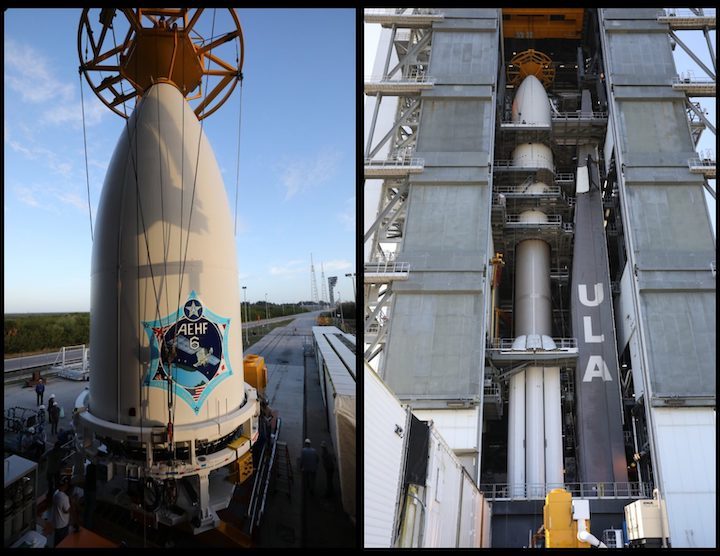
For only the second time this year, the roar of an Atlas V will break the early afternoon stillness of Cape Canaveral on Thursday, when United Launch Alliance (ULA) aims to deliver its first major payload to orbit on behalf of the newly-inaugurated U.S. Space Force. Liftoff of AEHF-6—the sixth and final member in a fleet of Advanced Extremely High Frequency communications satellites, to afford America’s civilian leaders fast and secure links with worldwide military assets—is scheduled to take place from Space Launch Complex (SLC)-41 at 2:57 p.m. EDT.
Coming a little over six weeks since the successful launch of Solar Orbiter, this mission marks the 11th use of the Atlas V in its most powerful configuration, the 551, as well as the 500th use of an RL-10 upper-stage engine.
Quelle: AS
----
Update: 26.03.2020
.
Start von Atlas 5 mit AEHF-6 Satelliten

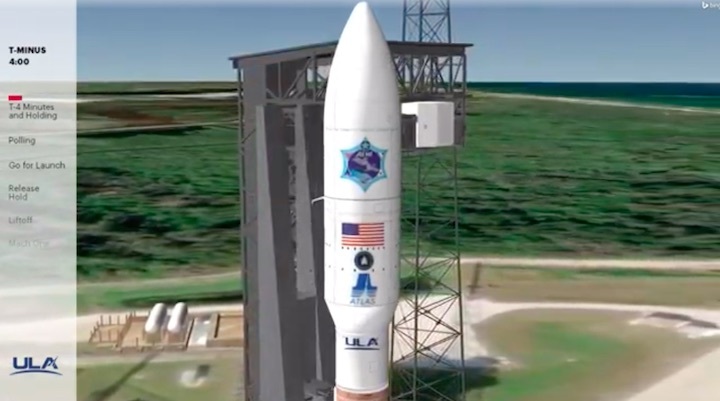

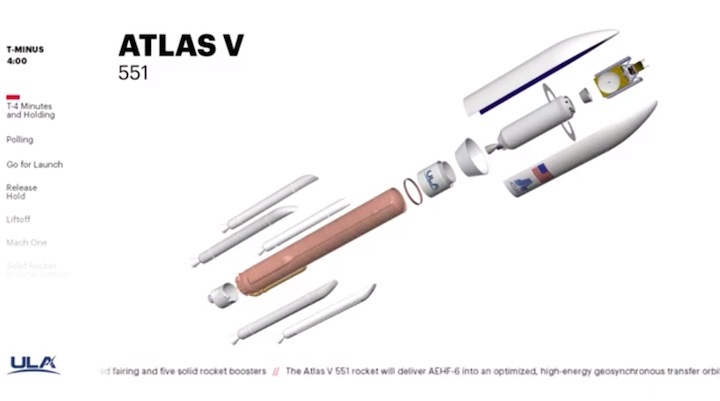
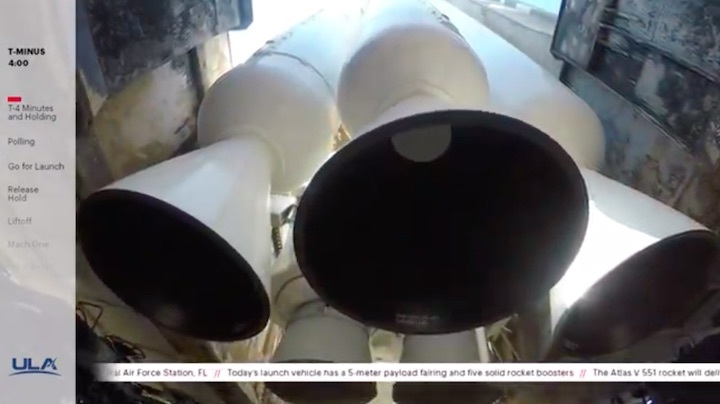
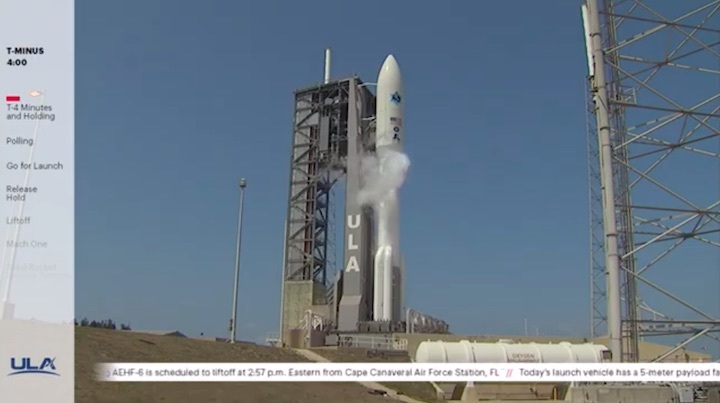
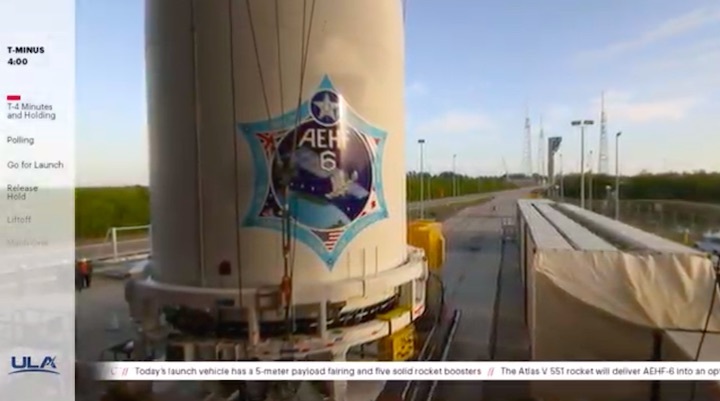
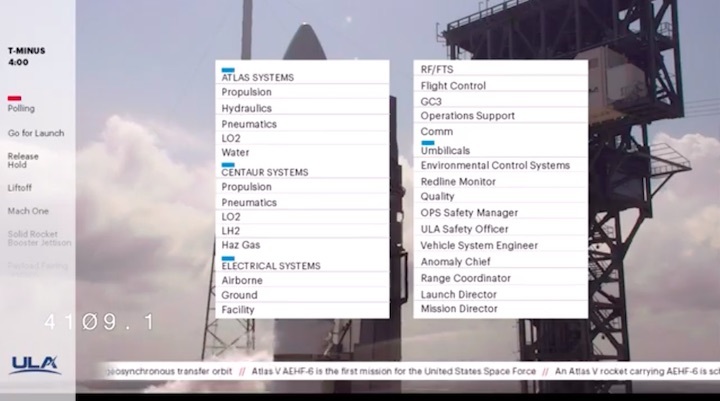
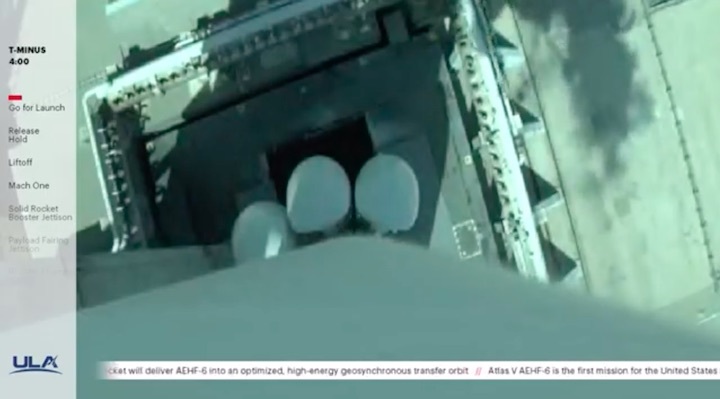
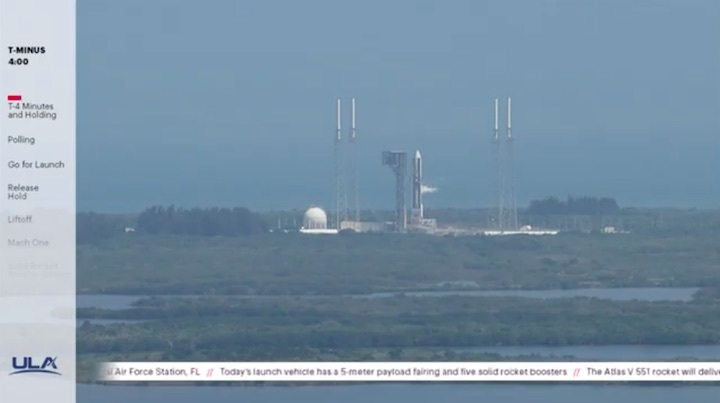
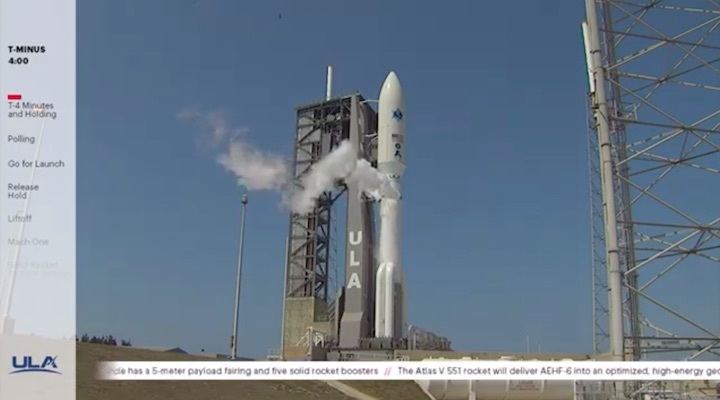
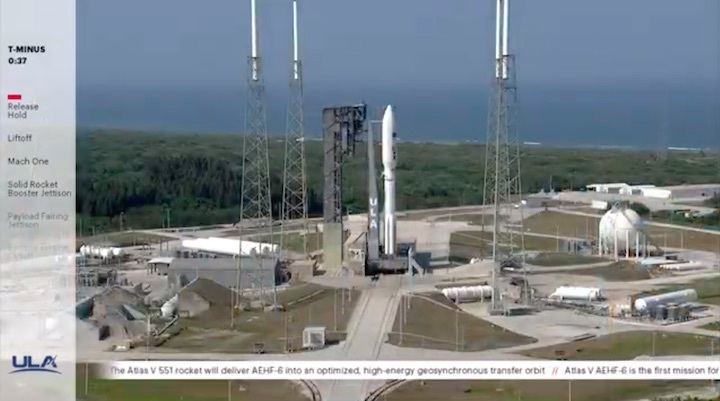
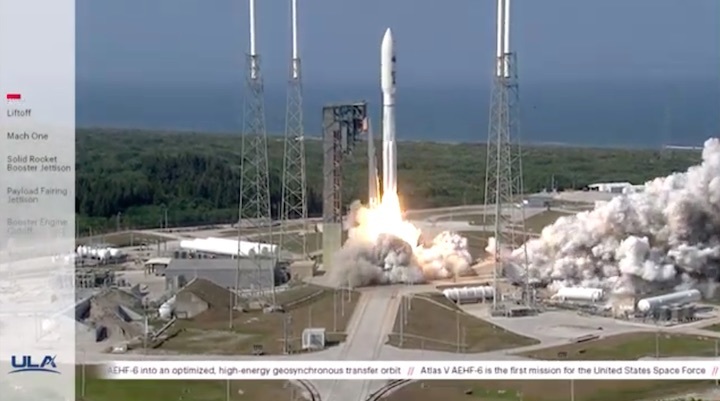
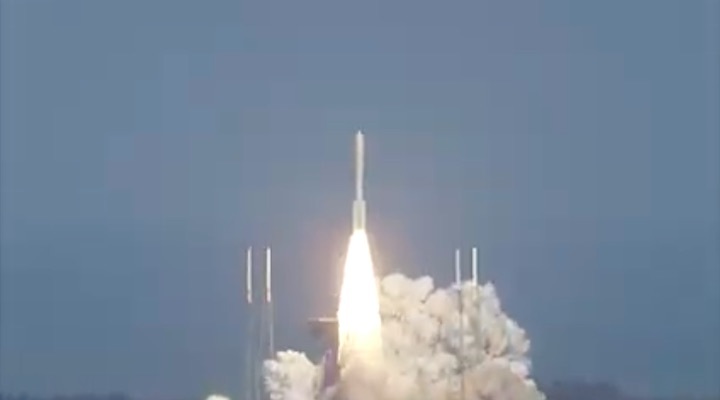

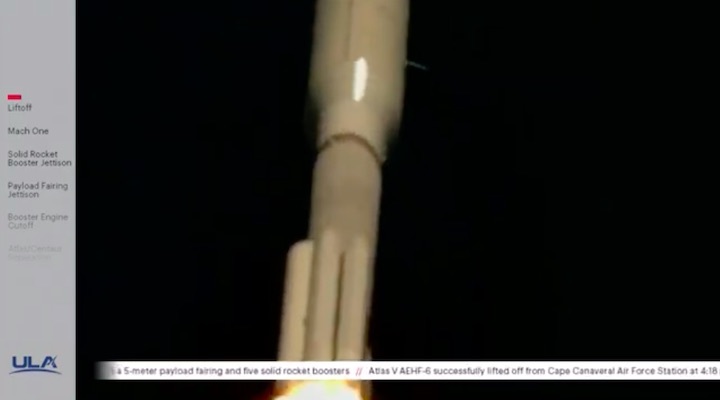

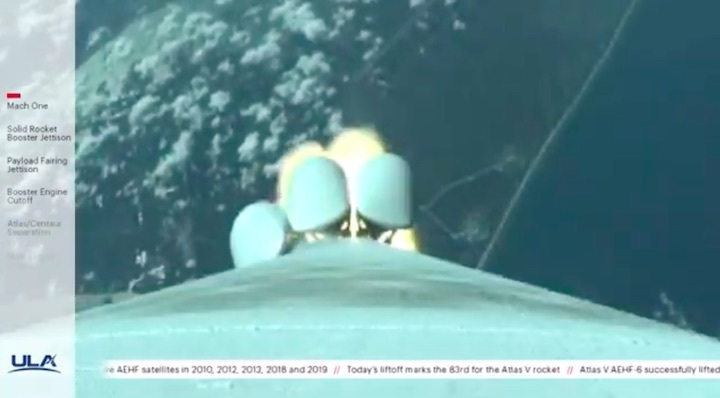
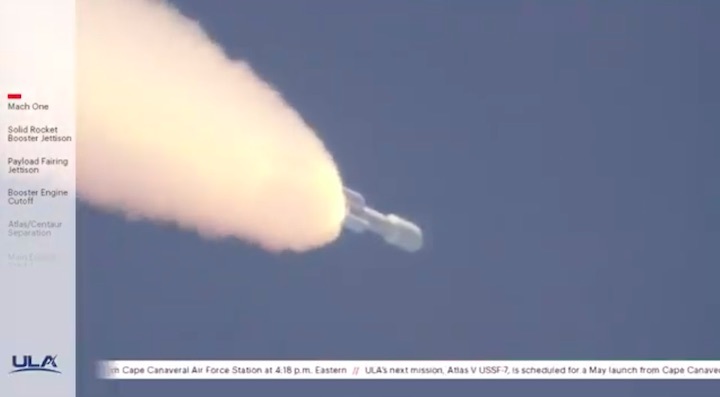

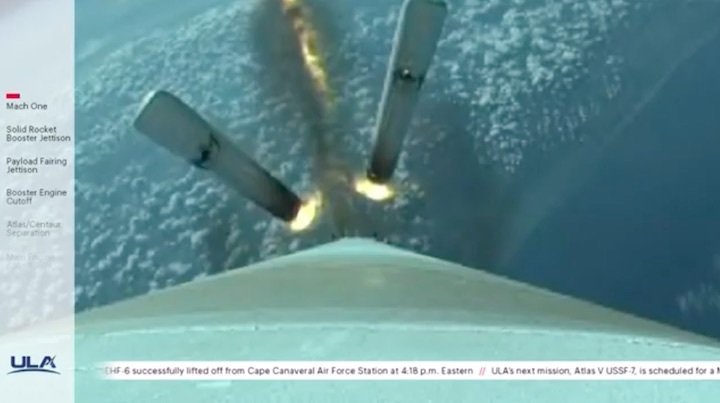
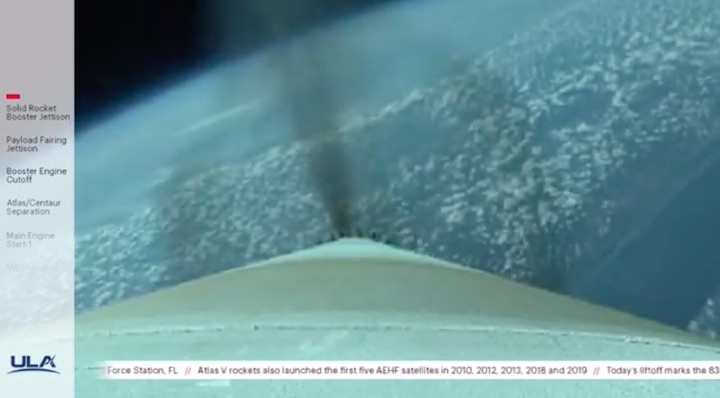
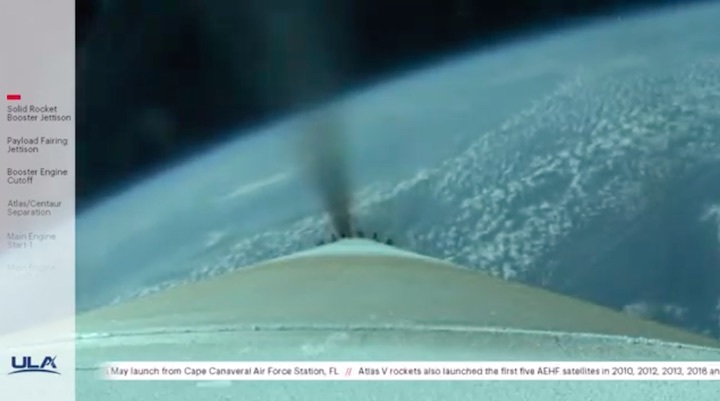


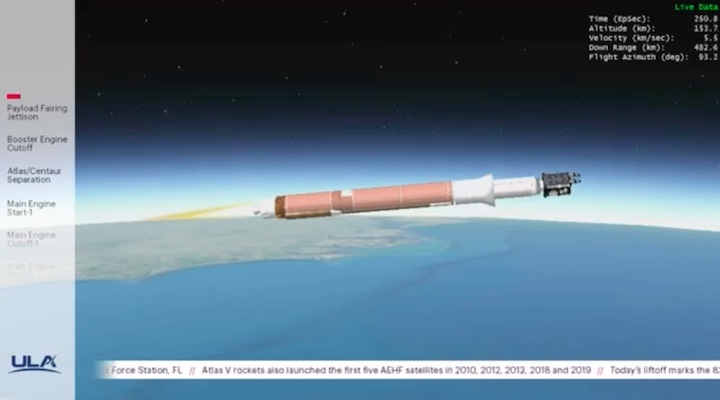
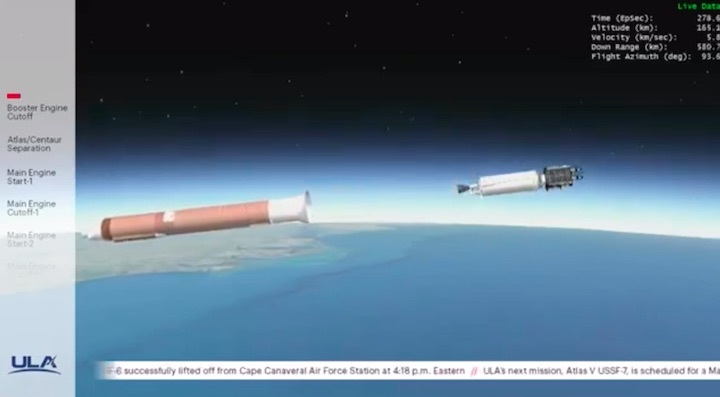
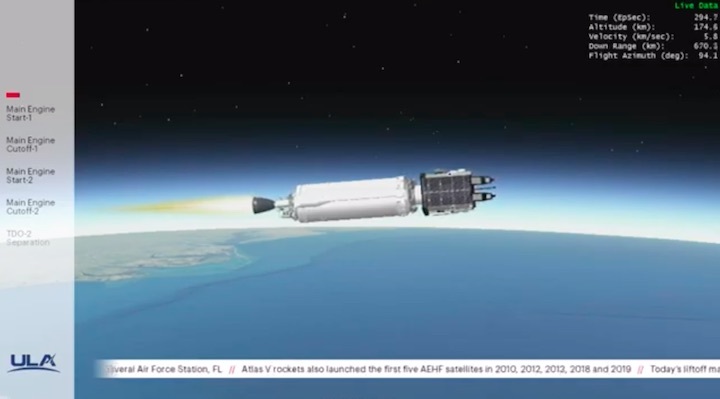

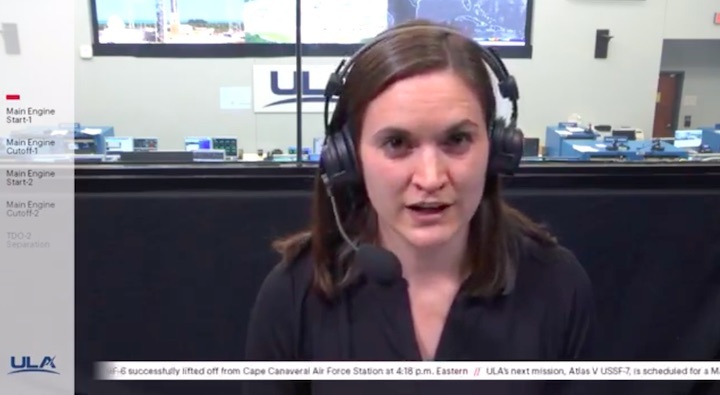

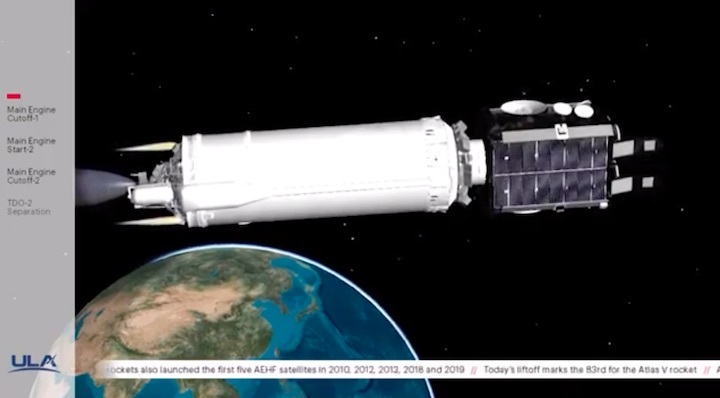

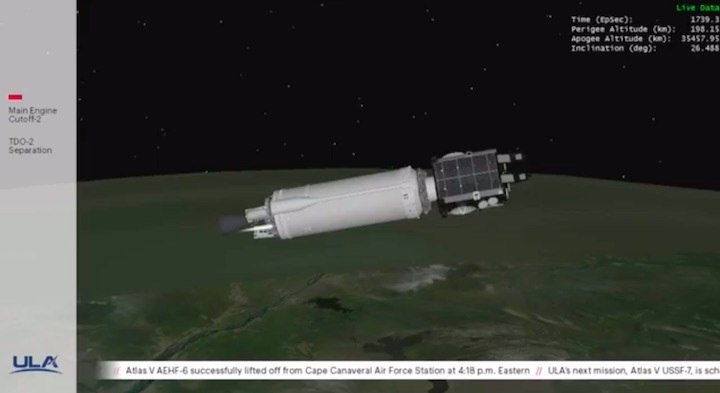
Quelle: ULA, USAF



